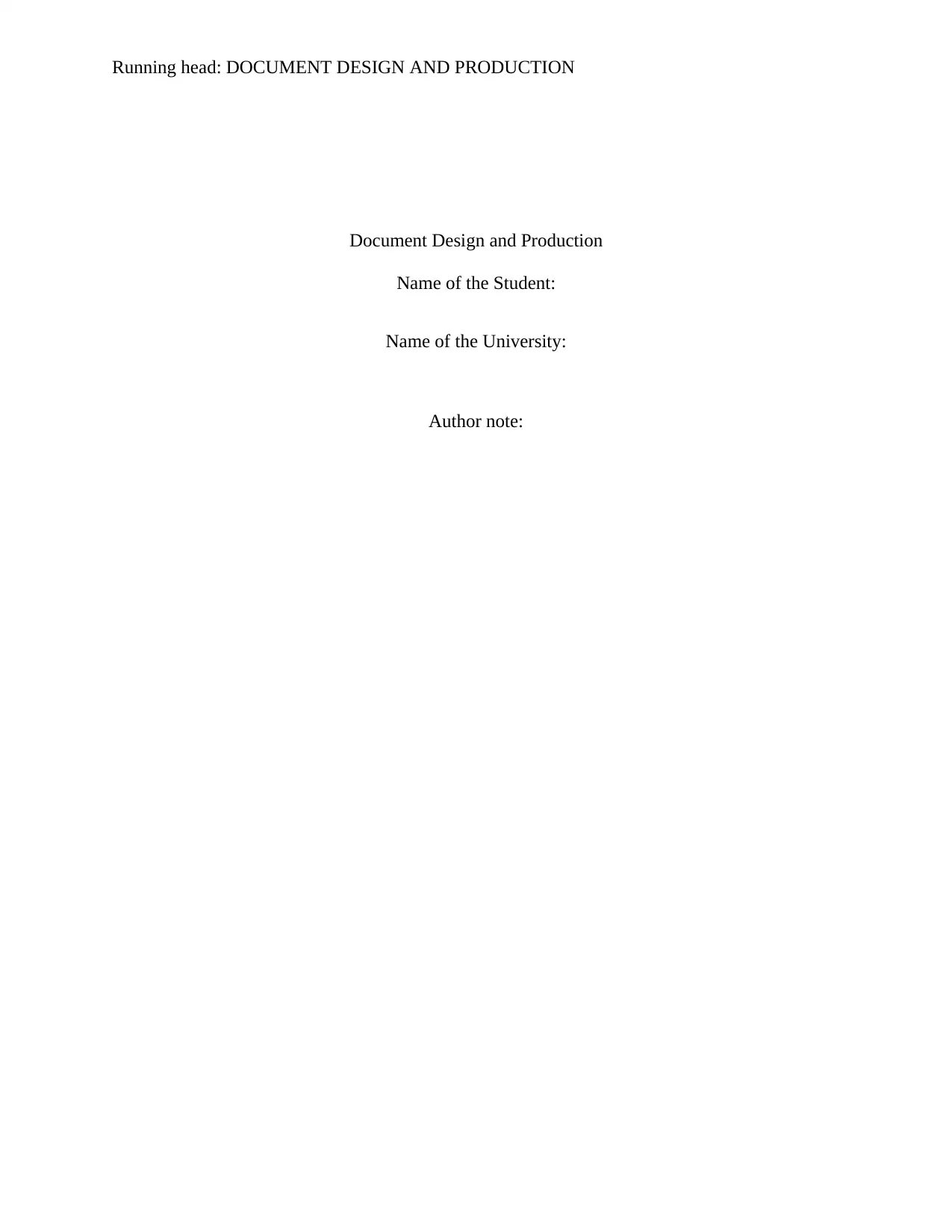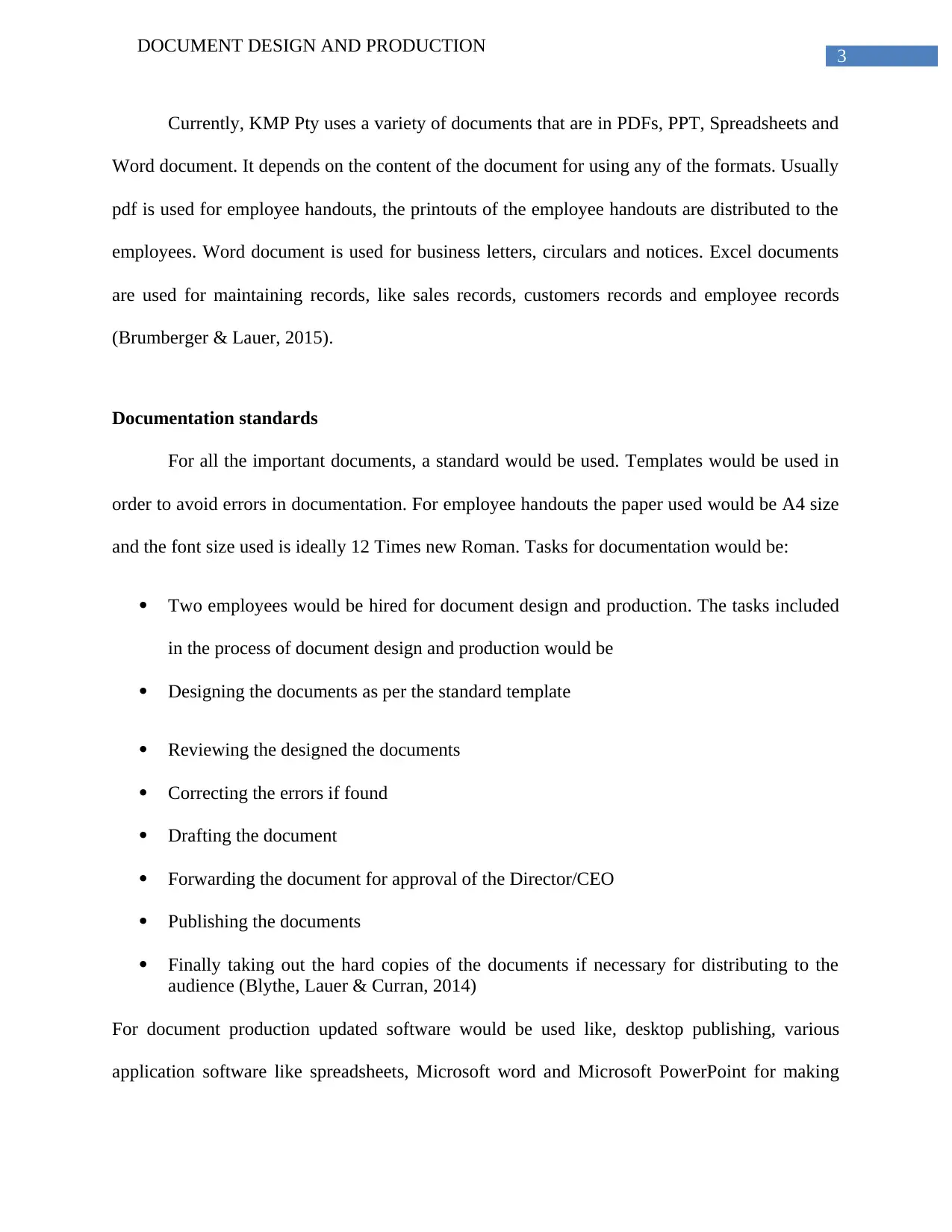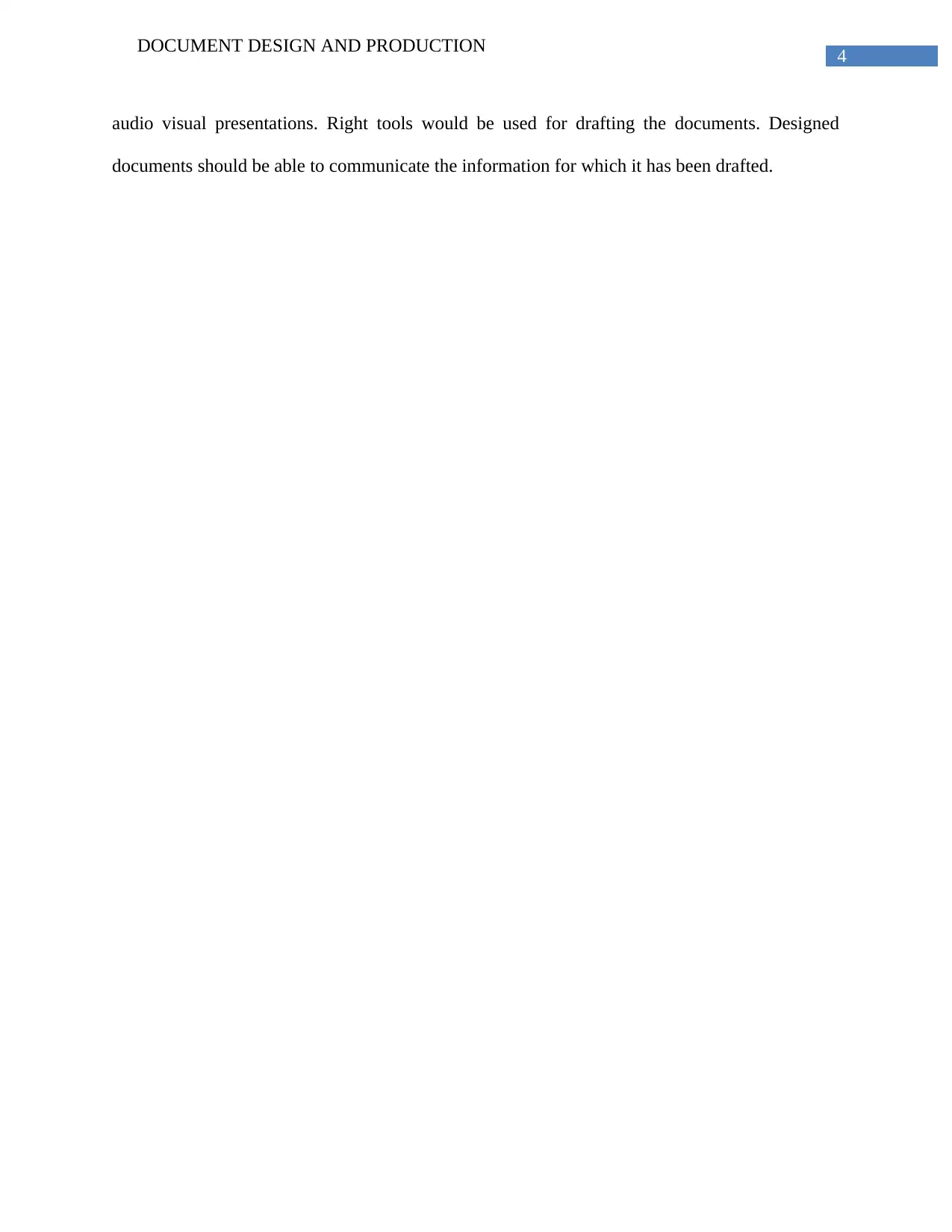Design and Production of Corporate Documents at KMP Pty
VerifiedAdded on 2020/04/21
|6
|1049
|135
AI Summary
The assignment delves into how organizations like KMP Pty manage documents using database systems for efficient information entry, storage, and output. Emphasizing the importance of document quality and standardization, it proposes hiring dedicated personnel for design and production tasks to minimize errors. Future expansions necessitate advanced technologies and standards, ensuring error-free communication essential for customer satisfaction and operational efficiency.

Running head: DOCUMENT DESIGN AND PRODUCTION
Document Design and Production
Name of the Student:
Name of the University:
Author note:
Document Design and Production
Name of the Student:
Name of the University:
Author note:
Paraphrase This Document
Need a fresh take? Get an instant paraphrase of this document with our AI Paraphraser

1
DOCUMENT DESIGN AND PRODUCTION
Company Background
In an organization useful information are maintained in the database of the company and
is maintained and updated timely. The process involves inputting the financial data, account of
customers and personal information and medical records or purchase orders into the computer
system of the company. In many cases, the information entry involves administrative duties like
typing memos, forwarding circulars and delivering mails. KMP Pty is a textile manufacturer that
employs 500 employees. Documents of each of the departments are processed separately.
Information Entry
As soon as any information enters the organization it is being processed. Previously the
data entry and management was done manually. The company now uses computer system for
maintaining important data. That information that is not to be circulated to the employees are
generally stored in the data base of the company with the help database management system
software. Important documents of the organization include memos, business letters, reports,
budgets, employee handouts, notices, circulars and others.
Storage
The crucial information of the organization is stored in the computer systems. Database
management system is the software that company uses for storage of the data. Important dat if
not protected properly might be lost (Turner et al., 2016). Data therefore needs to be stored.
Previously KMP Pty used to store important data in the files and folders.
DOCUMENT DESIGN AND PRODUCTION
Company Background
In an organization useful information are maintained in the database of the company and
is maintained and updated timely. The process involves inputting the financial data, account of
customers and personal information and medical records or purchase orders into the computer
system of the company. In many cases, the information entry involves administrative duties like
typing memos, forwarding circulars and delivering mails. KMP Pty is a textile manufacturer that
employs 500 employees. Documents of each of the departments are processed separately.
Information Entry
As soon as any information enters the organization it is being processed. Previously the
data entry and management was done manually. The company now uses computer system for
maintaining important data. That information that is not to be circulated to the employees are
generally stored in the data base of the company with the help database management system
software. Important documents of the organization include memos, business letters, reports,
budgets, employee handouts, notices, circulars and others.
Storage
The crucial information of the organization is stored in the computer systems. Database
management system is the software that company uses for storage of the data. Important dat if
not protected properly might be lost (Turner et al., 2016). Data therefore needs to be stored.
Previously KMP Pty used to store important data in the files and folders.

2
DOCUMENT DESIGN AND PRODUCTION
Output
Some of the information will be stored while some will be drafted in form of documents
for distribution among the employees. Soft copies of the information will be mailed to the
employees while hard copies, the print outs of the document would be distributed to the
employees. The company allocates 5 percent of its total budget for document design and
production (Leijten et al., 2015).
Quality of document design and production
The business letters, notices, forms, reports and budgets would be made using templates.
Formal language would be used for drafting the contents of the documents.
Company’s future capability
In future, the company is planning to expand its business in two other cities as well.
Expansion of the company might require more documentation. The amount of information will
also increase. I future the company will have a separate department that will take care of
document design and production. As the number of employees would increase, the requirement
for circulating necessary documents will also increase. Information technology will also be
advanced in future. New technologies might be used for data storage and processing. KMP will
also require changing the technology it uses for data storage. Currently the company distributes
documents like, memos and circulars with emails. Hard copies of notices and employee handouts
are distributed among the employees. The company is planning to improve the quality of the
documents by setting a standard for documentation. Previously no such standards where used
and hence there were many errors in the document. The errors even caused confusion for the
customers (Campbell, 2013).
DOCUMENT DESIGN AND PRODUCTION
Output
Some of the information will be stored while some will be drafted in form of documents
for distribution among the employees. Soft copies of the information will be mailed to the
employees while hard copies, the print outs of the document would be distributed to the
employees. The company allocates 5 percent of its total budget for document design and
production (Leijten et al., 2015).
Quality of document design and production
The business letters, notices, forms, reports and budgets would be made using templates.
Formal language would be used for drafting the contents of the documents.
Company’s future capability
In future, the company is planning to expand its business in two other cities as well.
Expansion of the company might require more documentation. The amount of information will
also increase. I future the company will have a separate department that will take care of
document design and production. As the number of employees would increase, the requirement
for circulating necessary documents will also increase. Information technology will also be
advanced in future. New technologies might be used for data storage and processing. KMP will
also require changing the technology it uses for data storage. Currently the company distributes
documents like, memos and circulars with emails. Hard copies of notices and employee handouts
are distributed among the employees. The company is planning to improve the quality of the
documents by setting a standard for documentation. Previously no such standards where used
and hence there were many errors in the document. The errors even caused confusion for the
customers (Campbell, 2013).
⊘ This is a preview!⊘
Do you want full access?
Subscribe today to unlock all pages.

Trusted by 1+ million students worldwide

3
DOCUMENT DESIGN AND PRODUCTION
Currently, KMP Pty uses a variety of documents that are in PDFs, PPT, Spreadsheets and
Word document. It depends on the content of the document for using any of the formats. Usually
pdf is used for employee handouts, the printouts of the employee handouts are distributed to the
employees. Word document is used for business letters, circulars and notices. Excel documents
are used for maintaining records, like sales records, customers records and employee records
(Brumberger & Lauer, 2015).
Documentation standards
For all the important documents, a standard would be used. Templates would be used in
order to avoid errors in documentation. For employee handouts the paper used would be A4 size
and the font size used is ideally 12 Times new Roman. Tasks for documentation would be:
Two employees would be hired for document design and production. The tasks included
in the process of document design and production would be
Designing the documents as per the standard template
Reviewing the designed the documents
Correcting the errors if found
Drafting the document
Forwarding the document for approval of the Director/CEO
Publishing the documents
Finally taking out the hard copies of the documents if necessary for distributing to the
audience (Blythe, Lauer & Curran, 2014)
For document production updated software would be used like, desktop publishing, various
application software like spreadsheets, Microsoft word and Microsoft PowerPoint for making
DOCUMENT DESIGN AND PRODUCTION
Currently, KMP Pty uses a variety of documents that are in PDFs, PPT, Spreadsheets and
Word document. It depends on the content of the document for using any of the formats. Usually
pdf is used for employee handouts, the printouts of the employee handouts are distributed to the
employees. Word document is used for business letters, circulars and notices. Excel documents
are used for maintaining records, like sales records, customers records and employee records
(Brumberger & Lauer, 2015).
Documentation standards
For all the important documents, a standard would be used. Templates would be used in
order to avoid errors in documentation. For employee handouts the paper used would be A4 size
and the font size used is ideally 12 Times new Roman. Tasks for documentation would be:
Two employees would be hired for document design and production. The tasks included
in the process of document design and production would be
Designing the documents as per the standard template
Reviewing the designed the documents
Correcting the errors if found
Drafting the document
Forwarding the document for approval of the Director/CEO
Publishing the documents
Finally taking out the hard copies of the documents if necessary for distributing to the
audience (Blythe, Lauer & Curran, 2014)
For document production updated software would be used like, desktop publishing, various
application software like spreadsheets, Microsoft word and Microsoft PowerPoint for making
Paraphrase This Document
Need a fresh take? Get an instant paraphrase of this document with our AI Paraphraser

4
DOCUMENT DESIGN AND PRODUCTION
audio visual presentations. Right tools would be used for drafting the documents. Designed
documents should be able to communicate the information for which it has been drafted.
DOCUMENT DESIGN AND PRODUCTION
audio visual presentations. Right tools would be used for drafting the documents. Designed
documents should be able to communicate the information for which it has been drafted.

5
DOCUMENT DESIGN AND PRODUCTION
References
Blythe, S., Lauer, C., & Curran, P. G. (2014). Professional and technical communication in a
web 2.0 world. Technical Communication Quarterly, 23(4), 265-287.
Brumberger, E., & Lauer, C. (2015). The evolution of technical communication: An analysis of
industry job postings. Technical Communication, 62(4), 224-243.
Campbell, K. S. (2013). Coherence, continuity, and cohesion: Theoretical foundations for
document design. Routledge.
Leijten, M., Van Waes, L., Schriver, K., & Hayes, J. R. (2014). Writing in the workplace:
Constructing documents using multiple digital sources. Journal of Writing
Research, 5(3), 285-337.
Turner, J., Schomberg, J., Cole, K., Bergman, B. J., Kurtz, D., Peters, V., & Bothmann, R. L.
(2016). Inclusivity, gestalt principles, and plain language in document design. The
Library with the Lead Pipe.
DOCUMENT DESIGN AND PRODUCTION
References
Blythe, S., Lauer, C., & Curran, P. G. (2014). Professional and technical communication in a
web 2.0 world. Technical Communication Quarterly, 23(4), 265-287.
Brumberger, E., & Lauer, C. (2015). The evolution of technical communication: An analysis of
industry job postings. Technical Communication, 62(4), 224-243.
Campbell, K. S. (2013). Coherence, continuity, and cohesion: Theoretical foundations for
document design. Routledge.
Leijten, M., Van Waes, L., Schriver, K., & Hayes, J. R. (2014). Writing in the workplace:
Constructing documents using multiple digital sources. Journal of Writing
Research, 5(3), 285-337.
Turner, J., Schomberg, J., Cole, K., Bergman, B. J., Kurtz, D., Peters, V., & Bothmann, R. L.
(2016). Inclusivity, gestalt principles, and plain language in document design. The
Library with the Lead Pipe.
⊘ This is a preview!⊘
Do you want full access?
Subscribe today to unlock all pages.

Trusted by 1+ million students worldwide
1 out of 6
Related Documents
Your All-in-One AI-Powered Toolkit for Academic Success.
+13062052269
info@desklib.com
Available 24*7 on WhatsApp / Email
![[object Object]](/_next/static/media/star-bottom.7253800d.svg)
Unlock your academic potential
Copyright © 2020–2025 A2Z Services. All Rights Reserved. Developed and managed by ZUCOL.





